 |
| After you have captured stones, they are of use one more time. After the game is over, you fill in the opponent's territory with the stones you have captured. In short, if the opponent has a territory of 20 points, and you have captured five stones, you use these stones to fill in five of the points in his territory, so he ends up with only 15 points. Capturing stones is fun in itself, and you can also enjoy yourself at the end of the game, so capturing is twice the fun. |
 |
[1]Concerning captives (using them to fill in the opponent's territory)

(a) Stones taken off the board
· You use the stones you have captured to fill in the opponent's territory. In Dia. 1, Black can capture the two marked white stones. |
 |
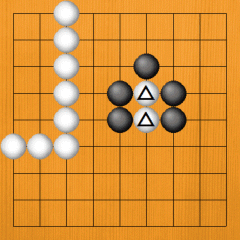
Dia. 1 |
|
In Dia. 2, Black captures the two stones. Black's territory here is two points. |
 |
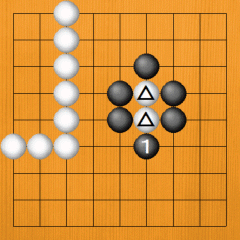
Dia. 2 |
|
Dia. 3. At the end of the game, the two captured white stones are placed in White's territory. Not only does Black make two points of territory by capturing the stones, he further reduces White's territory by two. Consequently, capturing two stones is worth four points. |
 |
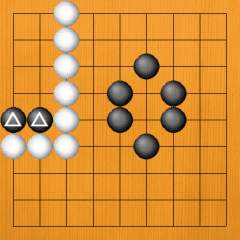
Dia. 3 |
|
Dia. 4. It's the same even if the number of stones increases. Black can capture the three marked white stones. |
 |
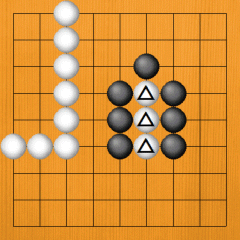
Dia. 4 |
|
This is shown in Dia. 5. Next --> |
 |
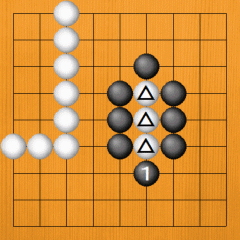
Dia. 5 |
|
Dia. 6. Black places the stones in White's territory. At the same time as making three points of territory, Black also reduces White's territory by three points, so his profit from the capture is six points. |
 |
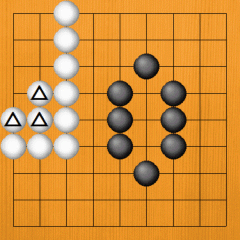
Dia. 6 |
(b) Captured stones
· Let's look at the case of stones that are captured even though they are not removed from the board. In Dia. 7, there is one marked white stone inside Black's territory. This stone is captured as it is, and after the game is finished Black can place it inside White's territory. |
 |
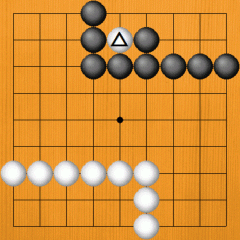
Dia. 7 |
|
Dia. 8. Black removes the marked stone from the X point and places it inside White's territory. Black gets a point (the X point) and reduces White's territory by a point, so he has gained two points. |
 |
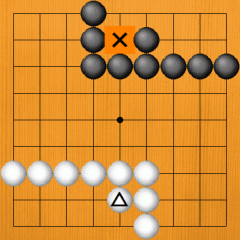
Dia. 8 |
|
It's the same in Dia. 9, because the marked white stone has been captured. |
 |
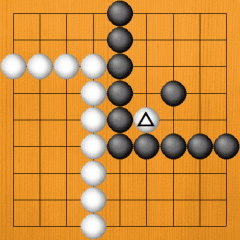
Dia. 9 |
|
Dia. 10. This stone can be placed inside White's territory, so White's territory is reduced by one and Black gains a point at X. |
 |
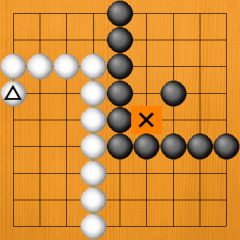
Dia. 10 |
|
· Dia. 11. Even multiple enemy stones can be captured like this. The four marked white stones can't escape, so Black captures them without adding any moves here. |
 |
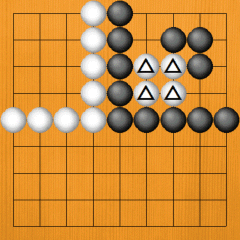
Dia. 11 |
|
Dia. 12. At the end of the game, Black takes the four stones off the board and places them inside White's territory. Black's territory increases by the four marked points and White's territory decreases by the four marked stones. |
 |
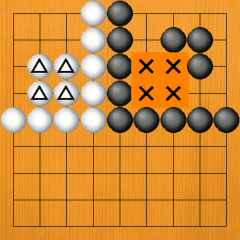
Dia. 12 |
|
· Dia. 13 is a little more complicated. Black has captured the two marked white stones and White the marked black stone. |
 |
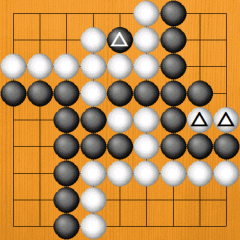
Dia. 13 |
|
Dia. 14. Both sides remove their captured stones and place them in the opponents' territories. Black gains the two X points but is reduced by the marked black stone. White gains the X point, but loses the two points from the marked white stones. |
 |
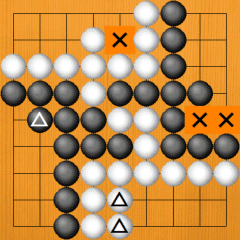
Dia. 14 |
(c) Stones that can be captured by both sides
· There are cases where either side could capture a stone. In Dia. 15, both the marked black stone and the marked white stone are in trouble. |
 |
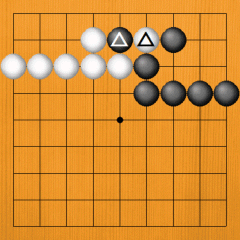
Dia. 15 |
|
If Black plays first, he can capture with 1 in Dia. 16. Next the border will be rounded off with White 2 and Black 3. |
 |
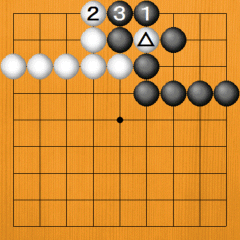
Dia. 16 |
|
Dia. 17. Furthermore, Black places the captured white stone inside White's territory. Black's territory increases by the two X points, and White's territory is reduced by one, so Black has made three points of profit from this capture. |
 |
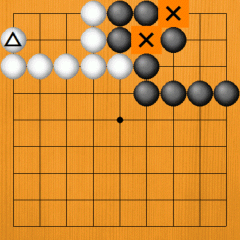
Dia. 17 |
|
· Dia. 18. On the other hand, if it is White's turn to play, he can capture the marked black stone with 1. The borders are finalized with Black 2 and White 3. |
 |
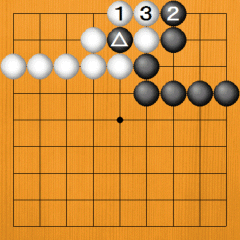
Dia. 18 |
|
Dia. 19. White places the marked black stone inside Black's territory, so White not only gains the two X points but also reduces Black's territory by one point, so White has gained three points from the capture. What that means is that there is a six-point difference depending on whether Black plays first or White plays first. In the final stage of the game, called the endgame, making six points just by capturing one stone is very big - it's a move that can't be slighted. Endgame skill often makes a difference to the result of the game. |
 |
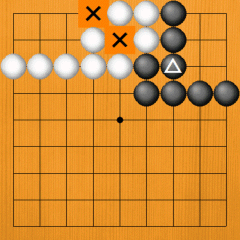
Dia. 19 |
|
· Dia. 20 shows a position in which two stones could be captured by either side. Whoever plays first can capture the marked stones of the opponent. |
 |
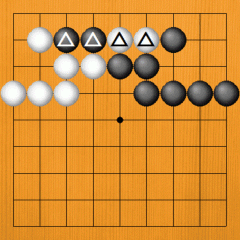
Dia. 20 |
|
Dia. 21. If it is Black's turn to play, he can capture the two marked white stones. Endgame play concludes with White 2 to Black 5. |
 |
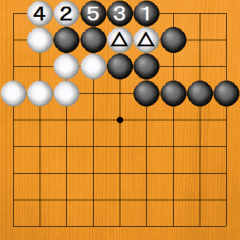
Dia. 21 |
|
Dia. 22. Black reduces White's territory by two points by placing the marked stones inside his territory and also gains the three X points, so his profit from the capture is five points. |
 |
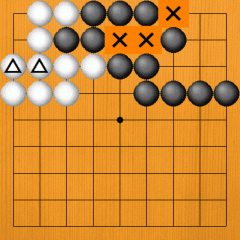
Dia. 22 |
|
Dia. 23. If, however, White plays first, he can capture the marked black stones with 1. The border is finalized with Black 2 to White 5. |
 |
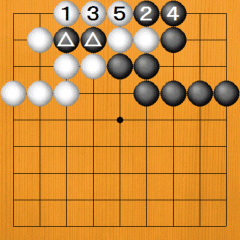
Dia. 23 |
Dia. 24. White places the marked black stones inside Black's territory, reducing it by two points while also increasing his territory by the three X points. His total profit is five points.
· The difference between Dias. 22 and 24 is 5+5 = 10. Capturing just two stones causes a difference of ten points in territory. |
 |
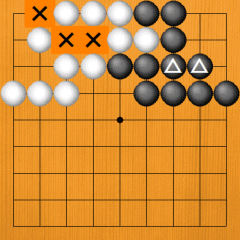
Dia. 24 |
· (Application 1) There are cases in which there are stones that have already been captured and stones that are going to be captured.
Dia. 25. Please consider what Black will play if it is his turn. The only area not yet decided is the top. Both the marked black stone and the marked white stone are in atari, that is, can be captured. |
 |
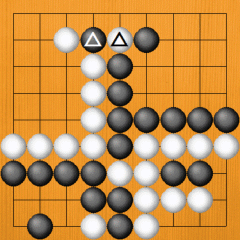
Dia. 25 |
|
Dia. 26. If it's Black's turn to play, he will capture with 1. The border is settled with White 2 and Black 3, and the game ends. Black will remove the marked stone at the bottom from the board, adding it to the stone he has just captured. White also removes the two marked black stones. |
 |
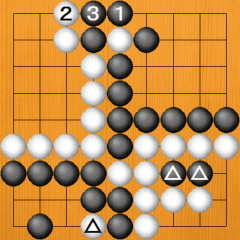
Dia. 26 |
|
Dia. 27. Both sides place the marked stones in the opponents' territories, then count each other's territories. Black has 14 points in the top right and six points in the bottom left, making a total of 20 points. White has 11 points in the top left and seven points in the bottom right, making a total of 18 points. Black wins the game by two points. |
 |
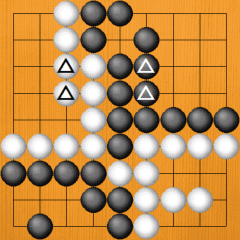
Dia. 27 |
|
 |